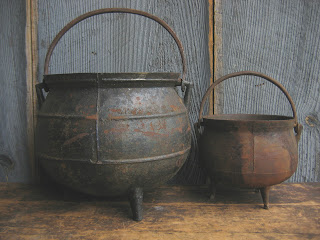







It is the black color, the round shape, the three legs to rest upon, the flared top opening and the thick handmade wrought iron handle hooked into the cast eyelets that forms the silhouette of a New England witch cauldron. It must have that silhouette and must have it from a distance. “Kettle” or “cauldron” may be determined by size but the former is smaller. The witch kettle, in actual usage, WAS smaller. The fireplace kitchen became too congested with a true cauldron and …it took a lot to fill it. The smaller kettle form was the workhorse of the colonial New England fireplace.
The form, to the eye, from a distance, is crucial. It MUST have that round, plump and ever slightly squat form. The top of the kettle’s opening lip MUST flare at an outward angle. The kettle color MUST be (preferably) fireplace blackened or, these days, an encrusted black-brown-rust color. The three feet MUST be “tall” meaning having not been fireplace “burnt-off” or buried-in-ground rusted “down”. The thick handmade handle MUST be that and not a bent wire handle that became common even by the late 18th century.
Must, must, must or it will not be a true New England witch cauldron. One may find dozens of “almost” kettles. Dozens & dozens of later “not” kettles. And a hundred dozen of “NO!” shaped cast iron fireplace cookware “pots”, most with lids. No: These are not a New England witch cauldron. This is understood commercially in the antique community; a true kettle will always “cost more” and that price is determined by knowing eyes and their glance from a distance. If a witch kettle is not one by glance and distance… it will never be one.
In the photographs we show two together; a medium size two gallon and a smaller one gallon. Both are classic fireplace kitchen size. Both have all the proper “musts” so are true early New England witch kettles. The small one gallon DOES convey it’s form from considerable distance. We include photographs of the handles and handle rings, the legs, the kettle bottoms (with their distinctive early casting line) and again note the flare to the tops. No lid… ever. Fireplace cooks and witches were always adding, stirring and ladling out so never wanted to fussed with a lid.
The key to the mind’s eye vision of the witch kettle is to keep the northern New England’s… 17th century… costal, dark, remote, late autumn wind swept cold… merged with the primitive fireplace burning in the dark in the battened down homestead, hovel or cabin… next to a dark footpath in the wilderness and… these merged with… skulking Indians, lone night travelers, old withered, craggy, boney, living-alone women … and a ragged black cat …with glowing yellow eyes. If the kettle conveys all that… it’s a good one.

No comments:
Post a Comment